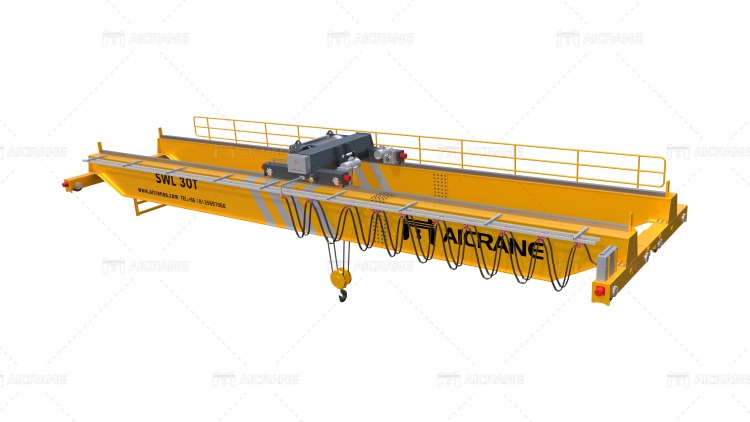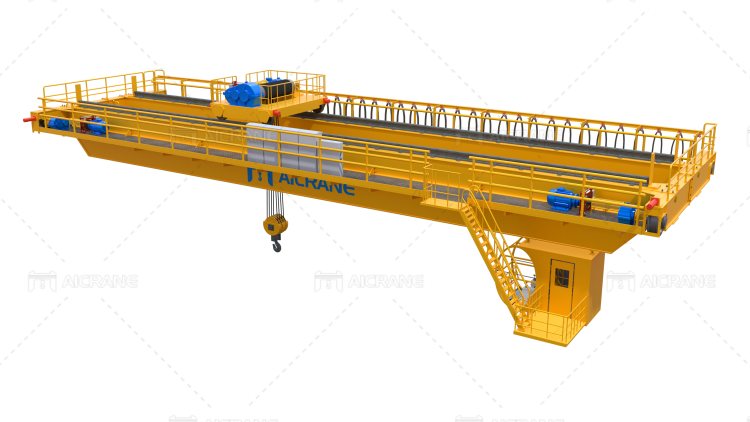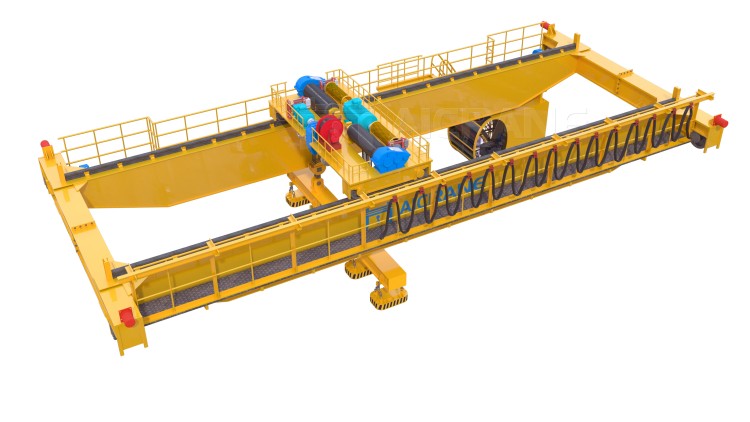In industries that require heavy lifting and efficient material handling, overhead cranes play a vital role. Among them, the overhead crane with a 30-ton capacity stands out as a powerful and reliable solution. With its ability to handle substantial loads, smart features, and the importance of regular inspections and maintenance, the overhead crane 30 ton is an indispensable asset for many industrial applications.
Uses and Applications
The overhead crane 30 ton is widely utilized in various industries such as manufacturing, construction, mining, shipping, and logistics. Its primary purpose is to lift and transport heavy loads with precision and safety. These cranes are commonly found in warehouses, steel mills, shipyards, and power plants, where they facilitate the movement of large components, machinery, containers, and raw materials.

Structure of A 30 ton Overhead Crane
The structure of a 30-ton overhead crane is designed to provide stability, strength, and durability to support the lifting and movement of heavy loads. While the specific design may vary depending on the manufacturer and application, the following components are commonly found in the structure of a 30-ton overhead crane:
- Bridge Girder: The bridge girder is the main horizontal beam that spans the width of the crane’s working area. It consists of two main girders, usually made of structural steel, which support the trolley and hoist mechanism. The bridge girder is designed to withstand the weight of the load and the forces generated during lifting and movement.
- End Trucks: The end trucks are located at either end of the bridge girder and house the wheels or tracks that enable the crane to move along the runway beams. They provide support and stability to the bridge girder while allowing it to traverse the length of the working area.
- Runway Beams: The runway beams are horizontal beams that run parallel to the bridge girder. They provide a stable track for the movement of the crane along the working area. The runway beams are securely mounted to the building structure or support columns to ensure stability and support the weight of the crane and the load.
- Trolley: The trolley is the mechanism that moves along the bridge girder horizontally. It consists of wheels or tracks that run along the top flange of the bridge girder, allowing the trolley to traverse the length of the crane. The trolley carries the hoist mechanism and facilitates the precise positioning of the load.
- Hoist Mechanism: The hoist mechanism is responsible for lifting and lowering the load. It typically consists of an electric or hydraulic hoist, which is mounted on the trolley and connected to a lifting hook or other lifting attachments. The hoist mechanism is designed to handle the rated capacity of the crane and ensure safe and controlled lifting operations.
- Electrical System: The electrical system of the overhead crane includes the power supply, control panel, and wiring that enable the operation of the crane. It controls the movement of the crane, including the bridge travel, trolley travel, and hoist operations. The electrical system also incorporates safety features such as limit switches, emergency stop buttons, and overload protection devices.
- Safety Features: To ensure safe operation, 30 ton overhead cranes are equipped with various safety features. These may include limit switches that prevent over-travel of the crane, emergency stop buttons for immediate shutdown, overload protection devices to prevent lifting beyond the crane’s rated capacity, and audible and visual warning devices to alert personnel of the crane’s movement.
Overall, the structure of a 30 ton overhead crane is designed to provide stability, durability, and safe operation while handling heavy loads. The combination of the bridge girder, end trucks, runway beams, trolley, hoist mechanism, electrical system, and safety features work together to facilitate efficient material handling operations in industrial settings. For more details of 30 ton overhead crane, just click here https://www.ellsencranes.com/30-ton-overhead-crane/.

Efficiency and Smart Features
Modern overhead cranes are equipped with advanced features that enhance their efficiency, safety, and productivity. Here are some of the notable smart features found in 30-ton overhead cranes:
- Load Control Systems: Load weighing and monitoring systems ensure that the crane operates within its specified capacity limits, preventing overloading accidents.
- Variable Speed Control: Adjustable speed control enables operators to handle loads smoothly and precisely, optimizing productivity and minimizing the risk of damage during lifting and positioning.
- Remote Control Operation: Wireless remote controls allow operators to control the crane from a safe distance, providing better visibility and reducing the risk of accidents.
- Collision Avoidance Systems: Sensors and cameras installed on the crane detect obstacles and alert the operator, preventing collisions and ensuring a safe working environment.
- Automation and Integration: Overhead cranes can be integrated into automated systems, allowing for seamless operation and increased productivity. They can also be connected to central control systems for efficient monitoring and maintenance.

Inspection and Maintenance
Regular inspections and proper maintenance are crucial to ensure the safe and reliable operation of the overhead crane 30 ton. Here are some key aspects to consider:
- Pre-Operation Inspections: Before each use, operators should inspect the crane visually, checking for any visible signs of damage, loose bolts, or worn-out components. They should also verify that all safety devices, such as limit switches and emergency stop buttons, are functioning correctly.
- Periodic Inspections: Qualified technicians should conduct more thorough inspections at regular intervals. These inspections involve examining critical components, such as wire ropes, hoist chains, brakes, and electrical systems, for signs of wear, corrosion, or malfunction. Non-destructive testing methods may be employed to detect hidden defects.
- Lubrication and Maintenance: Proper lubrication of moving parts is essential to reduce friction and prevent premature wear. Scheduled maintenance tasks, including adjusting brakes, aligning components, and tightening connections, should be carried out to ensure optimal performance and extend the crane’s lifespan.
- Training and Certification: Operators and maintenance personnel should receive comprehensive training on the operation, maintenance, and safety procedures specific to the overhead crane 30 ton. Certification programs can help ensure that individuals possess the necessary knowledge and skills to operate and maintain the crane safely.
The overhead crane 30 ton is a robust and efficient solution for heavy lifting in various industries. Its capacity to handle substantial loads, combined with smart features and advanced safety systems, makes it an indispensable asset. However, regular inspections and maintenance are crucial to ensure its safe and reliable operation. By following the recommended inspection and maintenance practices, industries can maximize the lifespan and performance of their overhead cranes, ensuring safe and efficient material handling operations.
